Abstract
Purpose
This study investigated the current trends and changes in the field of cataract surgery in Korea.
Methods
The members of the Korean Society of Cataract and Refractive Surgery (KSCRS) and the members of the Korean Ophthalmological Society (KOS) participated in a survey on cataract surgery in 2012, the 16th survey, consisting of 108 multi-ple-choice questions, mailed in July 2013 to 301 KSCRS and KOS members. Sixty two (20.6%) members answered the questions. Current data were compared with previous surveys performed in 2006 and 2009.
Results
Most of the respondents (46%) were in the fourth decade, 43% in the fifth decade and 10% in the sixth decade of life. The duration of hospital stay had decreased annually and the use of topical anesthesia (69%) was the most preferred. Self-seal-ing wound construction was the main wound closure technique in phacoemulsification (72%). The most preferred intraocular lens (IOL) for cataract surgery was hydrophobic acrylic (76%) which showed an increasing trend. The implantation of phakic IOL was performed by 41% of the respondents and interest in the value added IOLs such as presbyopia IOL and toric IOL had in-creased annually. In addition, to minimize astigmatism following cataract surgery, several methods were performed according to the degree of astigmatism. However, there was little interest in new cataract surgery techniques such as femtosecond laser and many respondents were skeptical whether to adopt the femtosecond laser cataract surgery system.
References
1. Shyn KH, Baek NH, Lee JH. . `95 Survey of Korean Society of Cataract and Refractive Surgery members. J Korean Ophthalmol Soc. 1998; 39:892–9.
2. Shyn KH, Shim JK, Sin SH, Park SW. 96 Survey of Korean Society of Cataract and Refractive Surgery members. J Korean Ophthalmol Soc. 1999; 40:403–8.
3. Shyn KH, Shin SH, Kim JS. `97 Survey of Korean society of Cataract and Refractive Surgery members. J Korean Ophthalmol Soc. 1999; 40:949–58.
4. Shyn KH, Park SW, Kim JS. Current trends in cataract and re-fractive surgery in Korea-1998 survey for KSCRS members. J Korean Ophthalmol Soc. 2000; 41:1523–31.
5. Shyn KH, Oh KH, Park GS. Current trends in cataract and re-fractive surgery in Korea: 1999 survey for KSCRS members. J Korean Ophthalmol Soc. 2001; 42:713–23.
6. Shyn KH, Kim YS, Ha SW. Current trends in cataract and re-fractive surgery in Korea 2000 survey for KSCRS (Korean society of Cataract and Refractive Surgery) members. J Korean Ophthalmol Soc. 2002; 43:1007–14.
7. Song YS, Lee JH, Shyn KH, Kim SW. 2001 survey for KSCRS members current trends in cataract and refractive surgery in Korea. J Korean Ophthalmol Soc. 2004; 45:45–54.
8. Shyn KH, Han YS, Lee JH. 2002 survey for KSCRS members: cur-rent trends in cataract and refractive surgery in Korea. J Korean Ophthalmol Soc. 2004; 45:55–63.
9. Shyn KH, Bae JY, Moon HS. 2003 survey for KSCRS members: current trends in cataract and refractive surgery in Korea. J Korean Ophthalmol Soc. 2005; 46:35–44.
10. Shyn KH, Chi MJ, Sohn HJ. 2004 survey for KSCRS members: current trends in cataract surgery in Korea. J Korean Ophthalmol Soc. 2006; 47:214–20.
11. Lee DY, Roh JH, Shyn KH. 2005 survey for KSCRS members: cur-rent trends in cataract surgery in Korea. J Korean Ophthalmol Soc. 2007; 48:485–92.
12. Paik HJ, Song HJ, Shyn KH. 2007 survey for KSCRS members: current trends in cataract surgery in Korea. J Korean Ophthalmol Soc. 2009; 50:1624–31.
13. Yoon SC, Jung JW, Sohn HJ, Shyn KH. Cataract and refractive sur-gery in; a survey of KSCRS members from 1995~2006. Korean J Ophthalmol. 2009; 23:142–7.
14. Leaming DV. Practice styles and preferences of ASCRS mem-bers-1985 survey. J Cataract Refract Surg. 1986; 12:380–4.

15. Leaming DV. Practice styles and preferences of ASCRS mem-bers-1986 survey. J Cataract Refract Surg. 1987; 13:561–7.

16. Leaming DV. Practice styles and preferences of ASCRS mem-bers-1987 survey. J Cataract Refract Surg. 1988; 14:552–9.
17. Leaming DV. Practice styles and preferences of ASCRS mem-bers-1988 survey. J Cataract Refract Surg. 1989; 15:689–97.
18. Leaming DV. Practice styles and preferences of ASCRS mem->bers-1989 survey. J Cataract Refract Surg. 1990; 16:624–32.
19. Leaming DV. Practice styles and preferences of ASCRS mem-bers-1990 survey. J Cataract Refract Surg. 1991; 17:495–502.

20. Leaming DV. Practice styles and preferences of ASCRS mem-bers-1991 survey. American Society of Cataract and Refractive Surgery. J Cataract Refract Surg. 1992; 18:460–9.
21. Leaming DV. Practice styles and preferences of ASCRS mem-bers-1992 survey. American Society of Cataract and Refractive Surgeons. J Cataract Refract Surg. 1993; 19:600–6.
22. Leaming DV. Practice styles and preferences of ASCRS mem-bers-1993 survey. J Cataract Refract Surg. 1994; 20:459–67.

23. Leaming DV. Practice styles and preferences of ASCRS mem-bers-1994 survey. J Cataract Refract Surg. 1995; 21:378–85.

24. Leaming DV. Practice styles and preferences of ASCRS mem-bers-1995 survey. J Cataract Refract Surg. 1996; 22:931–9.

25. Leaming DV. Practice styles and preferences of ASCRS mem-bers-1996 survey. J Cataract Refract Surg. 1997; 23:527–35.

26. Leaming DV. Practice styles and preferences of ASCRS mem-bers-1997 survey. J Cataract Refract Surg. 1998; 24:552–61.

27. Leaming DV. Practice styles and preferences of ASCRS mem-bers-1998 survey. J Cataract Refract Surg. 1999; 25:851–9.
28. Leaming DV. Practice styles and preferences of ASCRS mem-bers-1999 survey. J Cataract Refract Surg. 2000; 26:913–21.

29. Leaming DV. Practice styles and preferences of ASCRS mem-bers-2000 survey. J Cataract Refract Surg. 2001; 27:948–55.

30. Leaming DV. Practice styles and preferences of ASCRS mem-bers-2001 survey. J Cataract Refract Surg. 2002; 28:1681–8.

31. Leaming DV. Practice styles and preferences of ASCRS mem-bers-2002 survey. J Cataract Refract Surg. 2003; 29:1412–20.

32. Leaming DV. Practice styles and preferences of ASCRS mem-bers-2003 survey. J Cataract Refract Surg. 2004; 30:892–900.

34. Oshika T, Masuda K, Hayashi F, Leaming DV. Current trends in cataract and refractive surgery in Japan-1992 survey. Jpn J Ophthalmol. 1993; 37:432–44.
35. Oshika T, Masuda K, Hayashi F. . 1993 Survey of the Japanese Society of Cataract and Refractive Surgery members. Intraocular Lens and Refractive Surgery. 1994; 8:130–55.
36. Oshika T, Masuda K, Majima Y. . Current trends in cataract and refractive surgery in Japan: 1994 survey. Jpn J Ophthalmol. 1995; 39:265–73.
37. Oshika T, Masuda K, Majima Y. . Current trends in cataract and refractive surgery in Japan: 1995 survey. Jpn J Ophthalmol. 1996; 40:419–33.
38. Oshika T, Ariae M, Masuda K. . Current trends in cataract and refractive surgery in Japan: 1996 survey. Jpn J Ophthalmol. 1998; 42:227–41.

39. Oshika T, Ariae M, Masuda K. . Current trends in cataract and refractive surgery in Japan: 1997 survey. Jpn J Ophthalmol. 1999; 43:139–47.

40. Oshika T, Ariae M, Masuda K. . Current trends in cataract and refractive surgery in Japan: 1998 survey. Jpn J Ophthalmol. 2000; 44:268–76.

Figure 1.
Duration of admission for cataract surgery. Less than 1 day of hospitalization is 87%. KOR = Research for Korean Ophthalmological Society Members and Korean Society of Cataract and Refractive Surgery Members.
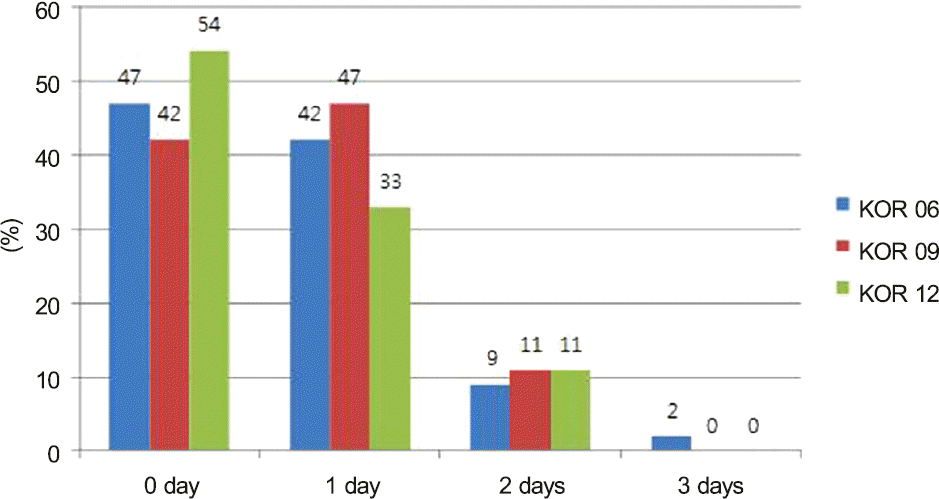
Figure 2.
Preferred methods of anesthesia for cataract operation. Topical anesthesia (69%) is the most popular method. R/B = fe-trobulbar anesthesia; Peribul = reribulbar anesthesia; Ten = subtenon anesthesia; Topical = topical anesthesia; KOR = Research for Korean Ophthalmological Society Members and Korean Society of Cataract and Refractive Surgery Members.
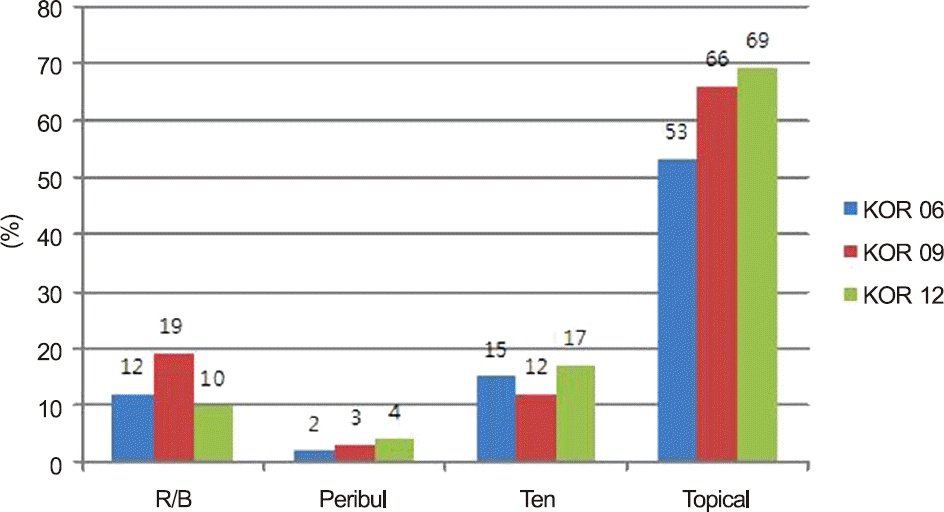
Figure 3.
Preferred size of incision in phacoemulsification. Small incision is preferred annually. KOR = Research for Korean Ophthalmological Society Members and Korean Society of Cataract and Refractive Surgery Members.
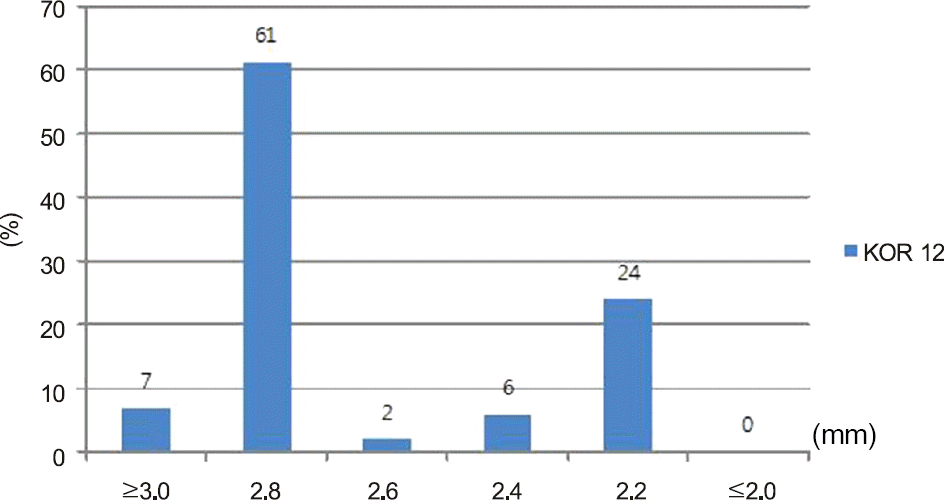
Figure 4.
Incision modes in phacoemulsification. Temporal incision (56%) is preferred. KOR = Research for Korean Ophthalmological Society Members and Korean Society of Cataract and Refractive Surgery Members; o/c = o'clock.
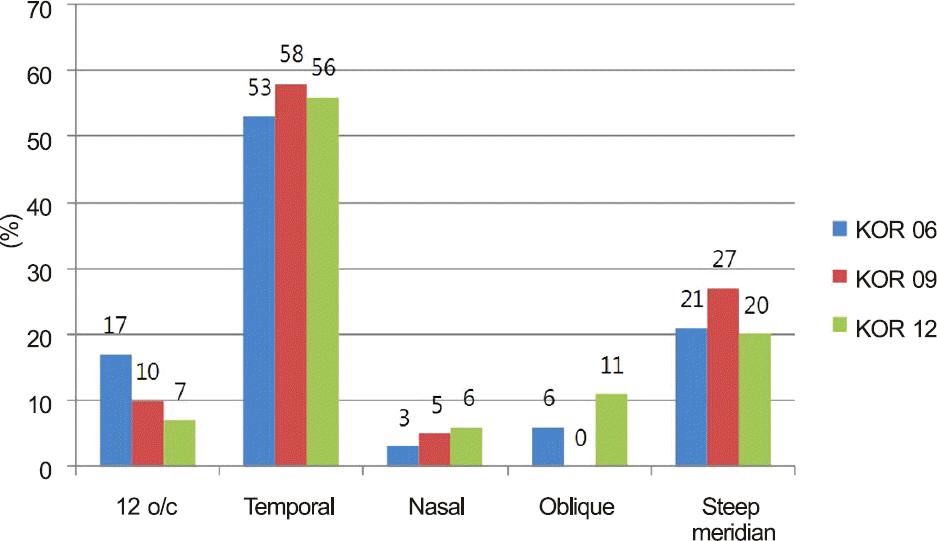
Figure 5.
Wound closure techniques in phacoemulsification. KOR = Research for Korean Ophthalmological Society Members and Korean Society of Cataract and Refractive Surgery Members.
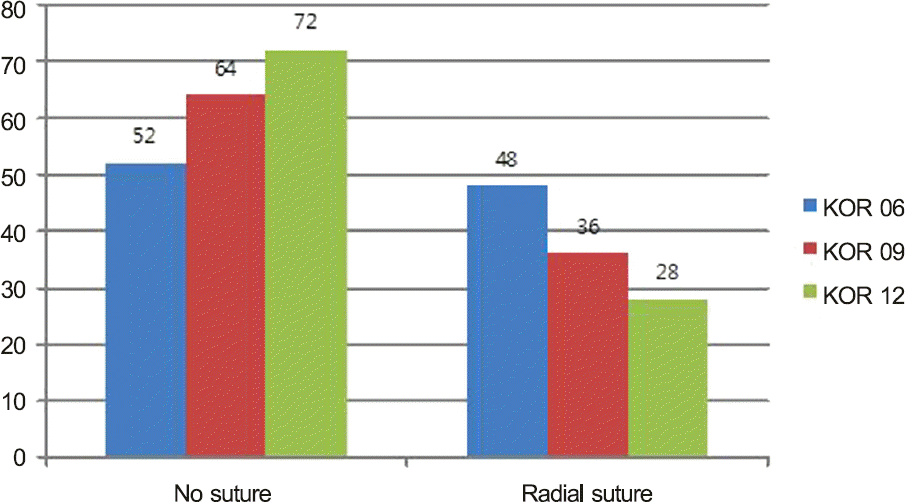
Figure 6.
Causes of intraocular lens (IOL) removal. IIOP = increased intraocular pressure; KOR = Research for Korean Ophthalmological Society Members and Korean Society of Cataract and Refractive Surgery Members.
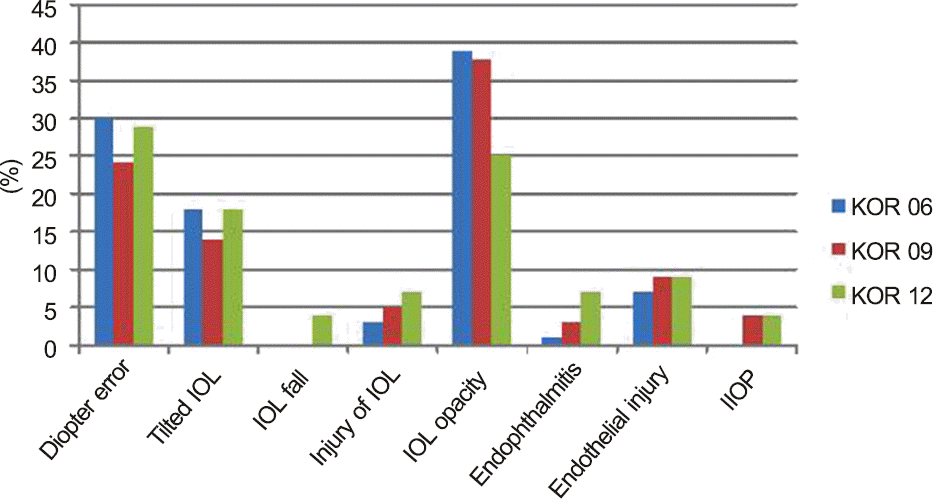




 PDF
PDF ePub
ePub Citation
Citation Print
Print


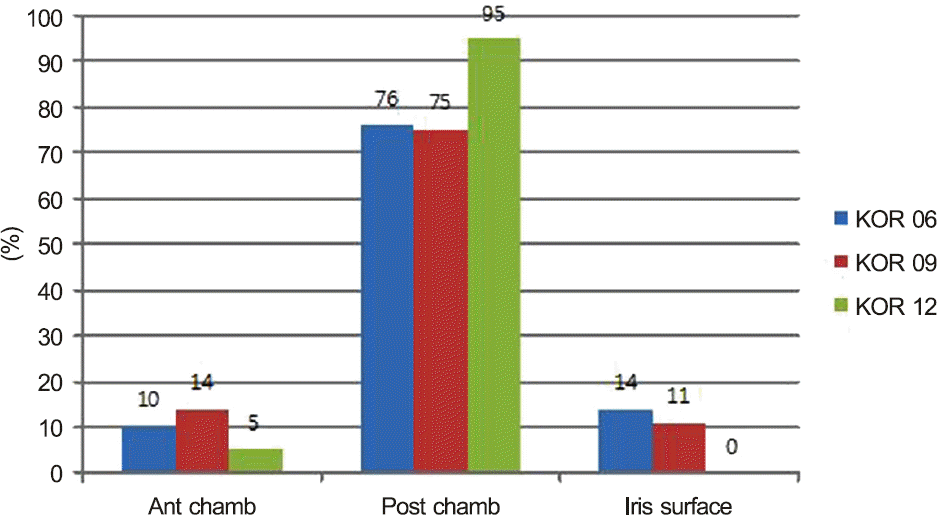
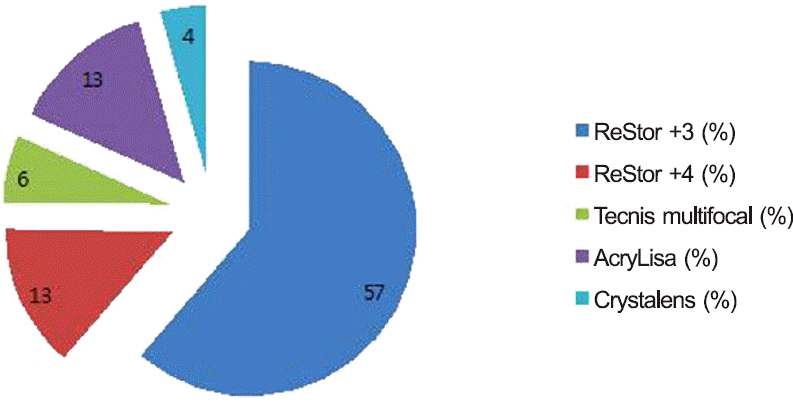
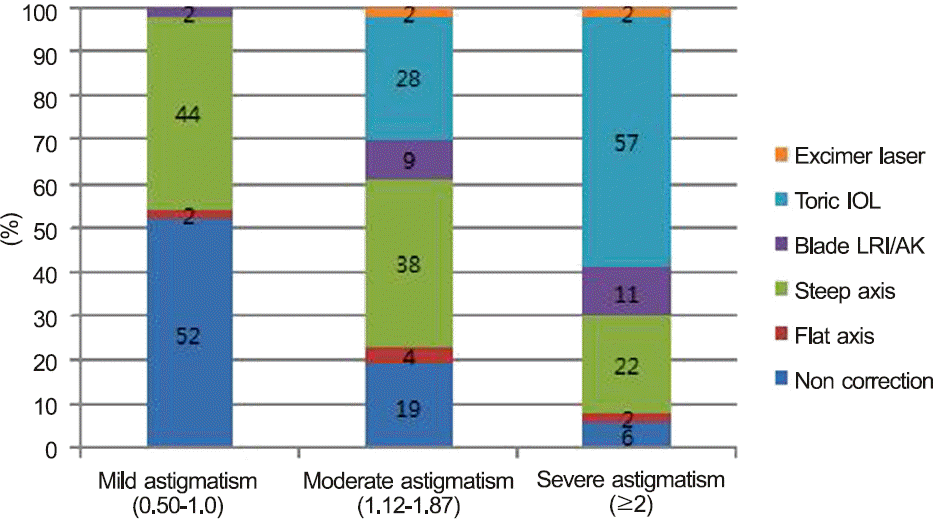
 XML Download
XML Download